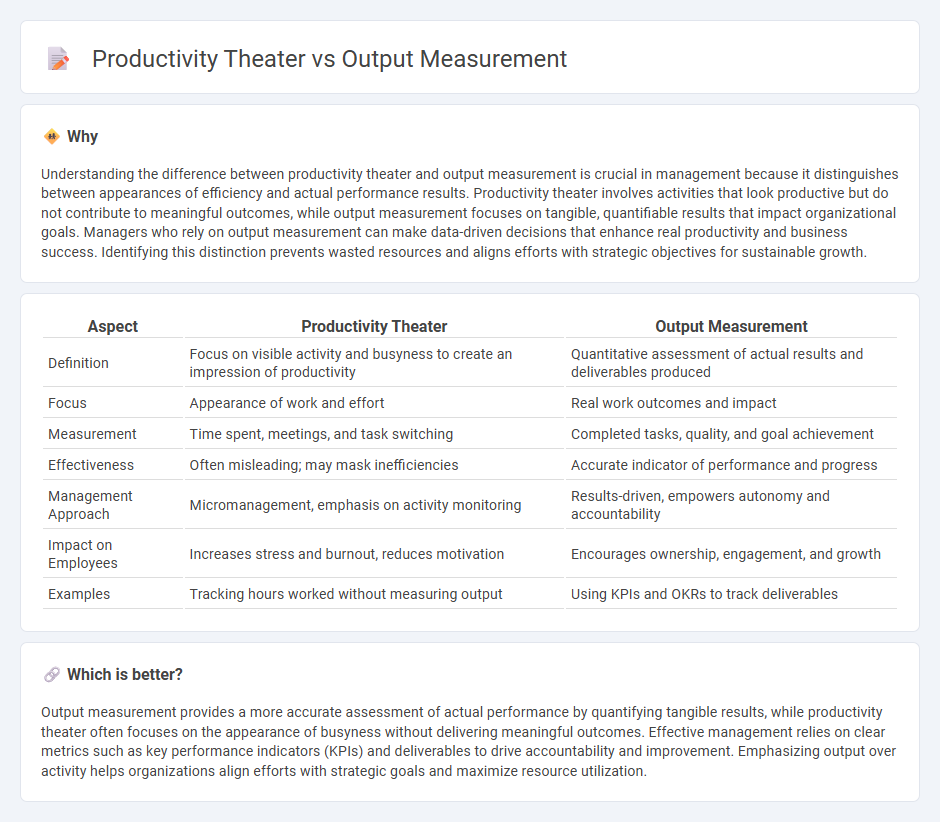
Management practices often involve distinguishing between productivity theater and genuine output measurement, where productivity theater refers to superficial indicators of activity that may not reflect actual results. Effective management focuses on measurable outcomes such as key performance indicators (KPIs) and deliverables that directly impact organizational goals. Explore how shifting from productivity theater to output measurement can enhance efficiency and strategic decision-making.
Why it is important
Understanding the difference between productivity theater and output measurement is crucial in management because it distinguishes between appearances of efficiency and actual performance results. Productivity theater involves activities that look productive but do not contribute to meaningful outcomes, while output measurement focuses on tangible, quantifiable results that impact organizational goals. Managers who rely on output measurement can make data-driven decisions that enhance real productivity and business success. Identifying this distinction prevents wasted resources and aligns efforts with strategic objectives for sustainable growth.
Comparison Table
| Aspect | Productivity Theater | Output Measurement |
|---|---|---|
| Definition | Focus on visible activity and busyness to create an impression of productivity | Quantitative assessment of actual results and deliverables produced |
| Focus | Appearance of work and effort | Real work outcomes and impact |
| Measurement | Time spent, meetings, and task switching | Completed tasks, quality, and goal achievement |
| Effectiveness | Often misleading; may mask inefficiencies | Accurate indicator of performance and progress |
| Management Approach | Micromanagement, emphasis on activity monitoring | Results-driven, empowers autonomy and accountability |
| Impact on Employees | Increases stress and burnout, reduces motivation | Encourages ownership, engagement, and growth |
| Examples | Tracking hours worked without measuring output | Using KPIs and OKRs to track deliverables |
Which is better?
Output measurement provides a more accurate assessment of actual performance by quantifying tangible results, while productivity theater often focuses on the appearance of busyness without delivering meaningful outcomes. Effective management relies on clear metrics such as key performance indicators (KPIs) and deliverables to drive accountability and improvement. Emphasizing output over activity helps organizations align efforts with strategic goals and maximize resource utilization.
Connection
Productivity theater involves creating the illusion of high efficiency without genuine performance improvement, often misleading output measurement results. Accurate output measurement requires transparent tracking of real work completed rather than superficial metrics that feed productivity theater. Effective management recognizes this connection to implement true performance indicators that drive meaningful productivity gains.
Key Terms
Key Performance Indicators (KPIs)
Output measurement provides quantifiable data on production volumes, enabling precise tracking of efficiency in processes, while productivity theater often masks inefficiencies through superficial metrics that do not reflect true performance. Key Performance Indicators (KPIs) such as cycle time, throughput, and defect rates serve as critical benchmarks to distinguish genuine productivity improvements from mere appearances. Explore comprehensive KPI strategies to enhance real productivity and eliminate productivity theater.
Value Creation
Output measurement often emphasizes quantifiable results, but this approach can overlook the true impact of value creation within an organization. Productivity theater occurs when activities are mistaken for meaningful progress, leading to inefficiencies and missed opportunities for innovation. Explore deeper strategies to align measurement systems with genuine value creation and enhance organizational performance.
Vanity Metrics
Output measurement often emphasizes quantitative metrics such as units produced or tasks completed, which can mislead organizations into valuing activity over meaningful results. Productivity theater occurs when companies prioritize vanity metrics like hours logged or superficial KPIs that appear impressive but do not reflect true efficiency or impact. Explore how shifting focus from output measurement to value-driven productivity can transform organizational performance.
Source and External Links
What is output measurement? - Focuskeeper Glossary - Output measurement is the process of quantifying the results produced by a specific action, process, or system, used as a benchmark to assess performance and productivity and improve decision-making and efficiency.
How is productivity measured? : Output - Bureau of Labor Statistics - Output is usually measured by the dollar amount sold of goods and services adjusted for price changes to separate quantity from price effects, especially in cases where businesses sell multiple products.
Measuring Outcomes vs. Measuring Output - What it Means, Why it's Important - Measuring output focuses on the quantity of activities or tasks completed by employees, such as sales calls made or tickets closed, serving as a traditional method to gauge productivity based on input vs. output.
 dowidth.com
dowidth.com